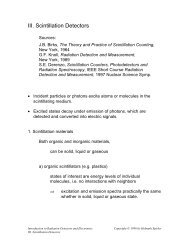Introduction to radiation-resistant semiconductor devices and circuits
Introduction to radiation-resistant semiconductor devices and circuits
Introduction to radiation-resistant semiconductor devices and circuits
You also want an ePaper? Increase the reach of your titles
YUMPU automatically turns print PDFs into web optimized ePapers that Google loves.
electron from the conduction b<strong>and</strong> (1c), which in turn can capture a hole (1d). This<br />
“recombination” process reduces current flowing in the conduction b<strong>and</strong>.<br />
Since the transition probabilities are exponential functions of the energy differences,<br />
all processes that involve transitions between both b<strong>and</strong>s require mid-gap<br />
states <strong>to</strong> proceed at an appreciable rate. Given a distribution of states these processes<br />
will “seek out” the mid-gap states. Since the distribution of states is not necessarily<br />
symmetric, one cannot simply calculate recombination lifetimes from generation<br />
currents <strong>and</strong> vice versa (as is possible for a single mid-gap state, as<br />
assumed in textbooks). Whether generation or recombination dominates depends<br />
on the relative concentration of carriers <strong>and</strong> empty defect states. In a depletion<br />
region the conduction b<strong>and</strong> is underpopulated, so generation prevails. In a forward<br />
biased junction carriers flood the conduction b<strong>and</strong>, so recombination dominates.<br />
Fig. 1 also shows a third phenomenon; defect levels close <strong>to</strong> a b<strong>and</strong> edge will capture<br />
charge <strong>and</strong> release it after some time, a process called “trapping” (Fig. 1e).<br />
FIGURE 1. Emission <strong>and</strong> capture processes through intermediate states. The arrows<br />
show the direction of electron transitions.<br />
In a <strong>radiation</strong> detec<strong>to</strong>r or pho<strong>to</strong>diode system the increased reverse-bias current<br />
increases the electronic shot noise. The change in doping level affects the width of<br />
the depletion region (or the voltage required for full depletion). The decrease in<br />
carrier lifetime incurs a loss of signal as carriers recombine while traversing the<br />
depletion region. As will be shown later, the same phenomena occur in transis<strong>to</strong>rs,<br />
but are less pronounced, depending on device type <strong>and</strong> structure. Displacement<br />
damage effects will be discussed in more detail in the section on diodes.<br />
5





